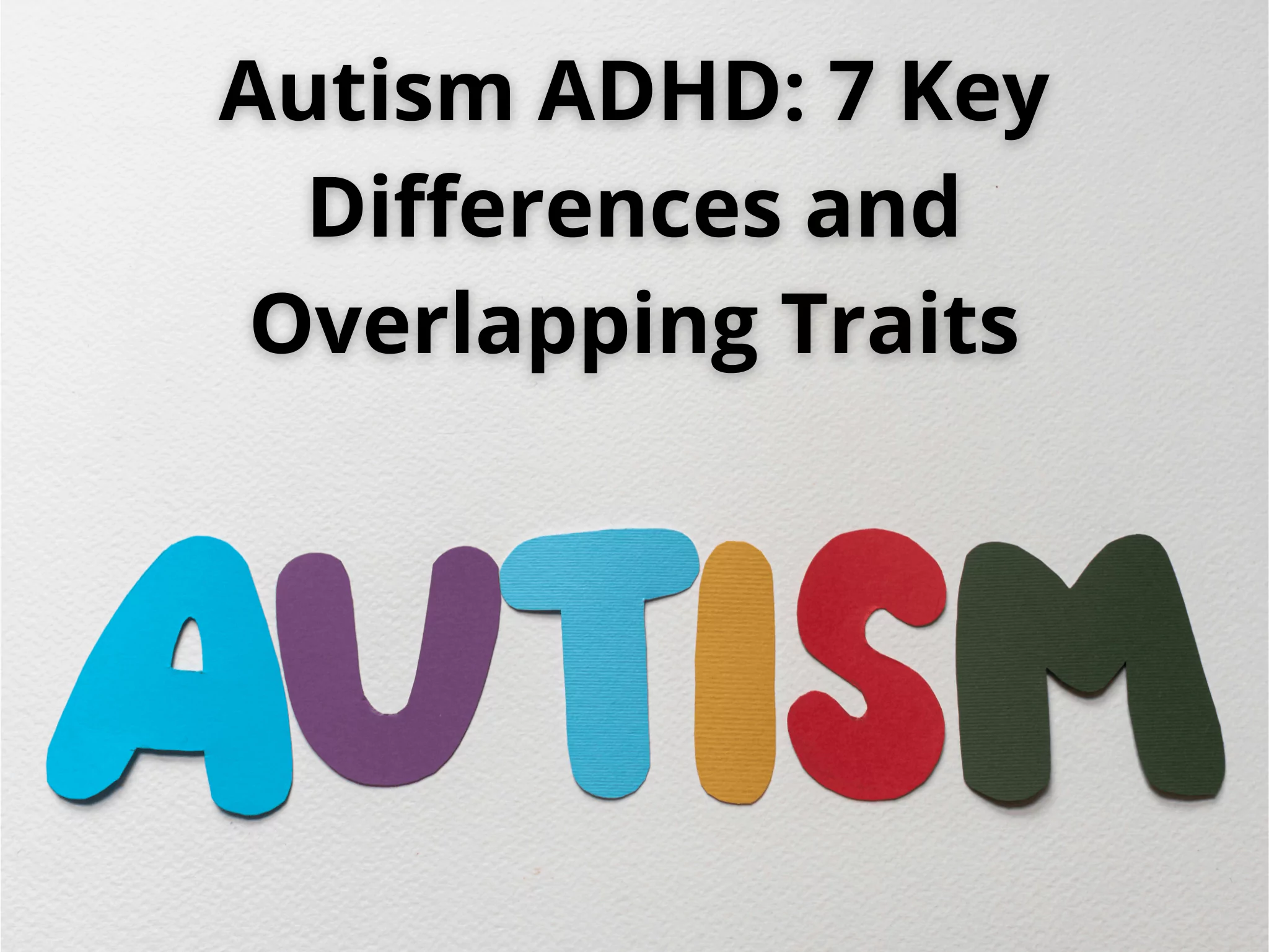With 9 years of experience in the kitchen, I’m passionate about crafting delicious recipes and sharing them with food lovers worldwide. 🍽️✨ Whether it’s a comforting homemade dish or a creative cocktail, my goal is to make cooking fun, easy, and enjoyable for everyone. Join me on this flavorful journey! 🍹🥗

Autism ADHD: 7 Key Differences and Overlapping Traits
Autism ADHD: 7 Key Differences and Overlapping Traits
Table of Contents
Understanding Autism and ADHD: Definition and Purpose
Both autism spectrum disorder (ASD) and attention-deficit/hyperactivity disorder (ADHD) are neurodevelopmental conditions that affect how individuals perceive the world and interact with others. Understanding the core characteristics of each is essential before delving into their differences and overlaps. Let’s define each condition to establish a solid foundation.
What is Autism Spectrum Disorder (ASD)?
Autism Spectrum Disorder (ASD) is a complex developmental condition that affects communication, social interaction, and behavior. The term “spectrum” indicates that the severity and presentation of symptoms can vary widely from person to person. According to the National Institute of Mental Health (NIMH), individuals with ASD may experience challenges with social reciprocity, nonverbal communication, and developing and maintaining relationships. They may also exhibit repetitive behaviors, restricted interests, and sensory sensitivities. To find out more about our services, check out our services page.
What is Attention-Deficit/Hyperactivity Disorder (ADHD)?
Attention-Deficit/Hyperactivity Disorder (ADHD) is another neurodevelopmental condition characterized by inattention, hyperactivity, and impulsivity. These symptoms can interfere with daily functioning in various settings, including school, work, and social situations. The Centers for Disease Control and Prevention (CDC) provides extensive resources on ADHD, highlighting that individuals with ADHD may struggle with focus, organization, and self-control. These challenges can impact academic performance, relationships, and overall quality of life.
Key Overlapping Traits of Autism and ADHD
While autism and ADHD are distinct conditions, they share several overlapping traits, which can sometimes make diagnosis and differentiation challenging. Recognizing these shared characteristics is crucial for accurate assessment and appropriate support.
Difficulties with Social Interaction
Both individuals with autism and ADHD can experience difficulties with social interaction, although the underlying reasons may differ. Individuals with autism may struggle with understanding social cues, interpreting body language, and engaging in reciprocal conversations. Those with ADHD, on the other hand, might face challenges with impulsivity, interrupting others, and maintaining attention during social interactions.
Challenges with Executive Functioning
Executive functioning skills, which include planning, organization, working memory, and impulse control, are often impaired in both autism and ADHD. This can manifest as difficulty completing tasks, managing time, prioritizing activities, and regulating emotions. Understanding these executive functioning deficits is essential for developing effective intervention strategies.
Sensory Sensitivities
Sensory sensitivities are commonly observed in both autism and ADHD. Individuals may be overly sensitive to certain sounds, lights, textures, or smells. These sensitivities can lead to discomfort, anxiety, and avoidance behaviors. Addressing sensory sensitivities is an important aspect of managing both conditions.
Emotional Regulation Challenges
Both conditions can affect emotional regulation. Individuals may experience difficulty managing their emotions, leading to increased irritability, frustration, or emotional outbursts. Developing coping mechanisms and emotional regulation strategies is crucial for improving overall well-being.
The Diagnostic Process for Autism and ADHD
Diagnosing autism and ADHD requires a comprehensive evaluation conducted by qualified professionals. The diagnostic process typically involves gathering information from multiple sources, including parents, teachers, and the individual themselves. It’s important to consult with experts who have experience in differentiating between these conditions.
Assessment Tools and Procedures
Various assessment tools and procedures are used to diagnose autism and ADHD. These may include standardized questionnaires, behavioral observations, and cognitive assessments. Some commonly used tools include the Autism Diagnostic Observation Schedule (ADOS), the Autism Diagnostic Interview-Revised (ADI-R), and the Conners Rating Scales for ADHD. A qualified healthcare professional will use these tools to gather data and make an informed diagnosis.
Importance of Differential Diagnosis
Differential diagnosis is critical when evaluating individuals for autism and ADHD. It involves systematically comparing the symptoms and characteristics of different conditions to determine the most accurate diagnosis. This process helps to rule out other potential explanations for the observed behaviors and ensures that individuals receive the most appropriate interventions.
Recognizing Symptoms of Autism and ADHD
Understanding the specific symptoms associated with autism and ADHD is essential for early identification and intervention. While there are overlapping traits, each condition also has distinct characteristics.
Common Symptoms of Autism
Common symptoms of autism include:
- Difficulties with social interaction and communication
- Repetitive behaviors or restricted interests
- Sensory sensitivities
- Challenges with nonverbal communication
- Difficulties with understanding social cues
Common Symptoms of ADHD
Common symptoms of ADHD include:
- Inattention and distractibility
- Hyperactivity and impulsivity
- Difficulties with organization and planning
- Challenges with task completion
- Forgetfulness and poor time management
Key Differences Between Autism and ADHD
While some symptoms overlap, there are significant differences between autism and ADHD. Recognizing these distinctions is crucial for accurate diagnosis and targeted interventions.
Social Interaction Styles
The nature of social interaction difficulties differs between autism and ADHD. Individuals with autism may have challenges understanding and responding to social cues, while those with ADHD may struggle with impulsivity and attention during social interactions. For example, an autistic individual might avoid eye contact due to sensory overload or difficulty interpreting social signals, whereas someone with ADHD might interrupt conversations due to impulsivity.
Focus and Attention Patterns
Individuals with autism often exhibit intense focus on specific interests, while those with ADHD typically struggle with sustained attention across various tasks. This difference in focus and attention patterns can impact academic performance and daily functioning. Someone with autism might spend hours researching a specific topic of interest, while someone with ADHD might have difficulty staying focused on a school assignment.
Repetitive Behaviors vs. Impulsivity
Repetitive behaviors are a core characteristic of autism, while impulsivity is a hallmark of ADHD. These distinct behavioral patterns can help differentiate between the two conditions. Autistic individuals might engage in repetitive motor movements or adhere to rigid routines, whereas individuals with ADHD might act without thinking or make impulsive decisions.
Autism and ADHD: Exploring Co-occurrence
It is possible for an individual to have both autism and ADHD, a condition known as co-occurrence. Research suggests that a significant percentage of individuals with autism also meet the criteria for ADHD, and vice versa. Understanding the complexities of co-occurring conditions is essential for providing comprehensive support.
Prevalence of Co-occurring Autism and ADHD
Studies have shown that a substantial number of individuals with autism also have ADHD. The exact prevalence rates vary, but estimates suggest that between 30% and 50% of individuals with autism also meet the diagnostic criteria for ADHD. This high rate of co-occurrence highlights the importance of screening for both conditions in individuals presenting with symptoms of either autism or ADHD.
Challenges in Diagnosing Co-occurring Conditions
Diagnosing co-occurring autism and ADHD can be challenging due to the overlapping symptoms and complexities of each condition. It requires a thorough evaluation that considers the individual’s developmental history, behavioral patterns, and cognitive functioning. Experienced professionals who are familiar with both autism and ADHD are best equipped to make an accurate diagnosis.
Impact of Co-occurrence on Daily Functioning
Co-occurring autism and ADHD can have a significant impact on daily functioning. Individuals may experience heightened challenges with social interaction, communication, attention, and behavior. The combined effects of these conditions can make it more difficult to succeed in school, work, and social settings. Comprehensive intervention strategies that address the unique needs of individuals with co-occurring autism and ADHD are essential for improving outcomes.
Management Strategies for Autism and ADHD
Effective management strategies for autism and ADHD involve a combination of behavioral interventions, educational support, and, in some cases, medication. The specific approach will depend on the individual’s unique needs and the severity of their symptoms. Learn more about our story on our about us page.
Behavioral Interventions
Behavioral interventions, such as Applied Behavior Analysis (ABA) for autism and Cognitive Behavioral Therapy (CBT) for ADHD, can help individuals develop coping skills, improve social interaction, and manage challenging behaviors. These therapies focus on teaching specific skills and strategies that can be used in various settings.
Educational Support
Educational support is crucial for individuals with autism and ADHD to succeed in school. This may include individualized education programs (IEPs), accommodations, and modifications to the curriculum. Creating a supportive and structured learning environment can help these students reach their full potential.
Medication Options
Medication may be considered as part of a comprehensive treatment plan for ADHD. Stimulant and non-stimulant medications can help improve attention, reduce hyperactivity, and control impulsivity. However, medication is not always necessary or appropriate for everyone, and the decision to use medication should be made in consultation with a qualified healthcare professional.
Available Support Options for Autism and ADHD
Numerous support options are available for individuals with autism and ADHD and their families. These resources can provide valuable information, guidance, and assistance in navigating the challenges of these conditions.
Parent Training Programs
Parent training programs offer education and support to parents of children with autism and ADHD. These programs teach parents effective strategies for managing behavior, improving communication, and promoting positive development. Parent training can empower families to create a supportive and nurturing environment for their children.
Support Groups
Support groups provide a forum for individuals with autism and ADHD and their families to connect with others who share similar experiences. These groups offer emotional support, practical advice, and a sense of community. Sharing experiences and learning from others can be incredibly beneficial.
Professional Therapists and Counselors
Professional therapists and counselors can provide individualized support to individuals with autism and ADHD. They can help with managing emotions, developing coping skills, and addressing specific challenges. Therapy can be a valuable resource for improving mental health and overall well-being. Consider contacting us for support.
Legal Implications and Advocacy for Autism and ADHD
Understanding the legal rights and protections available to individuals with autism and ADHD is essential for ensuring access to appropriate services and supports. Advocacy plays a crucial role in promoting the rights and needs of this population.
Understanding the Americans with Disabilities Act (ADA)
The Americans with Disabilities Act (ADA) is a federal law that prohibits discrimination against individuals with disabilities, including those with autism and ADHD. The ADA ensures that individuals with disabilities have equal access to employment, education, and public accommodations. Understanding the ADA can help individuals and families advocate for their rights.
Advocacy Organizations
Numerous advocacy organizations work to promote the rights and needs of individuals with autism and ADHD. These organizations provide information, resources, and support to individuals and families. They also advocate for policy changes that improve the lives of people with autism and ADHD. The Autism Speaks organization is a great resource for more information.
Frequently Asked Questions
What are the main differences between autism and ADHD?
While both conditions can share similar traits, the primary differences lie in social interaction styles, focus patterns, and the presence of repetitive behaviors. Autism often involves difficulties understanding social cues and a strong focus on specific interests, whereas ADHD is characterized by inattention, impulsivity, and hyperactivity.
Can someone be diagnosed with both autism and ADHD?
Yes, it is possible for an individual to be diagnosed with both autism and ADHD. This is referred to as co-occurrence, and it requires a comprehensive evaluation by qualified professionals to accurately diagnose and provide appropriate support.
What are some effective management strategies for individuals with both autism and ADHD?
Effective management strategies often involve a combination of behavioral interventions (like ABA and CBT), educational support, and, in some cases, medication. The specific approach should be tailored to the individual’s unique needs and symptoms.
Where can I find support for individuals with autism and ADHD and their families?
Support options include parent training programs, support groups, and professional therapists or counselors. Numerous advocacy organizations also provide valuable information, resources, and assistance.




